Evidence-Based Practice in Nursing: Impact on Patient Experience Essay
VerifiedAdded on 2023/01/11
|8
|2557
|58
Essay
AI Summary
This essay delves into the realm of evidence-based practice within nursing, specifically examining its influence on the patient experience. It commences with an introduction that underscores the significance of evidence-based practice, referencing the NMC Code and highlighting the chosen clinical practice aspect: preoperative fasting. The essay then meticulously formulates a research question using the PICO framework, concentrating on the reduction of preoperative anxiety through relaxation techniques. A comprehensive discussion of a selected research paper follows, evaluating its strengths and limitations using the CASP tool. The essay concludes by summarizing the findings and emphasizing the importance of incorporating psychological assessments and providing adequate preoperative information to patients. The study suggests that muscle relaxation, breathing exercises, and meditation are not widely used to reduce the anxiety level of pre-operative patients. Further research on the similar topic is needed in order to ensure better control of variables and taken into consideration the factors like length of intervention and the type of exercise required.
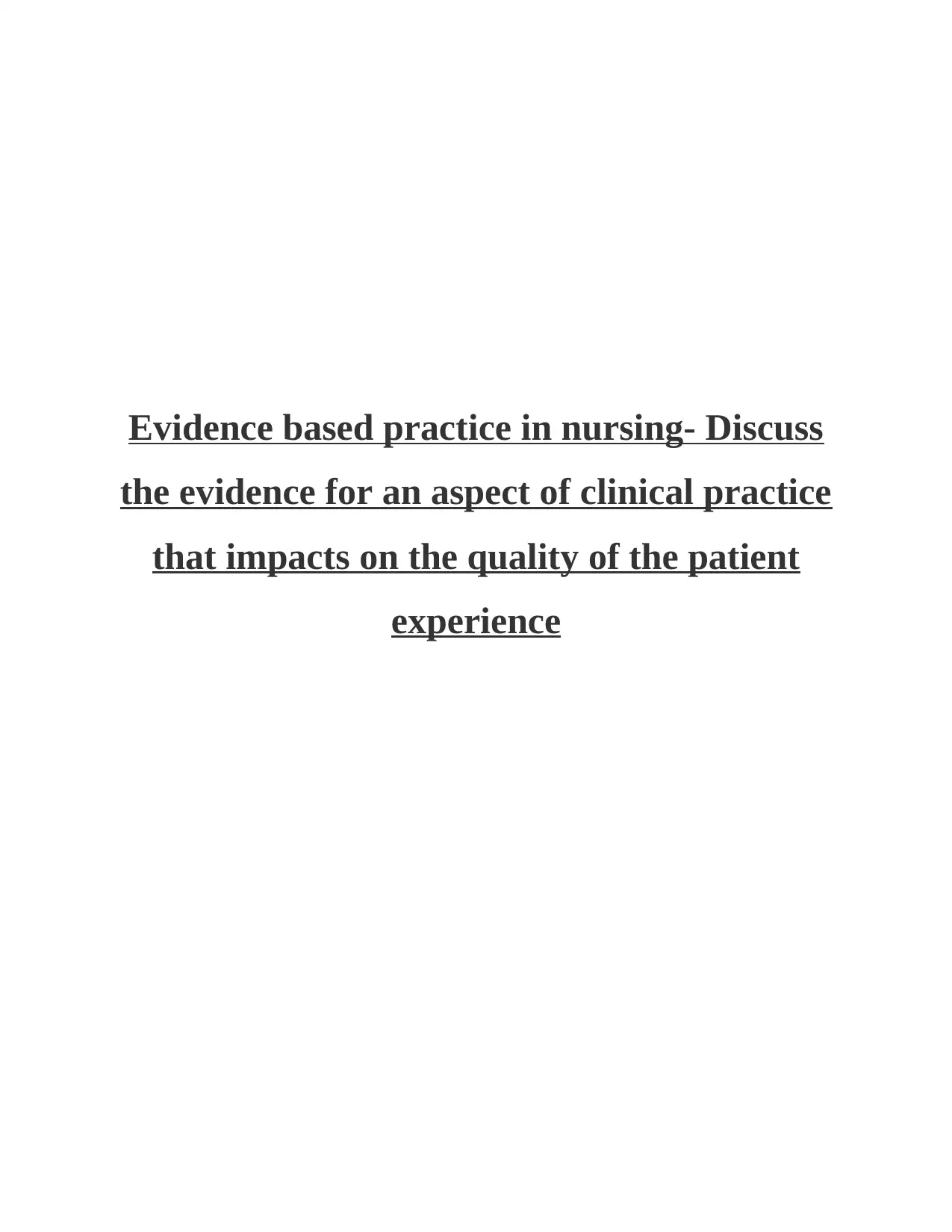
Evidence based practice in nursing- Discuss
the evidence for an aspect of clinical practice
that impacts on the quality of the patient
experience
the evidence for an aspect of clinical practice
that impacts on the quality of the patient
experience
Paraphrase This Document
Need a fresh take? Get an instant paraphrase of this document with our AI Paraphraser
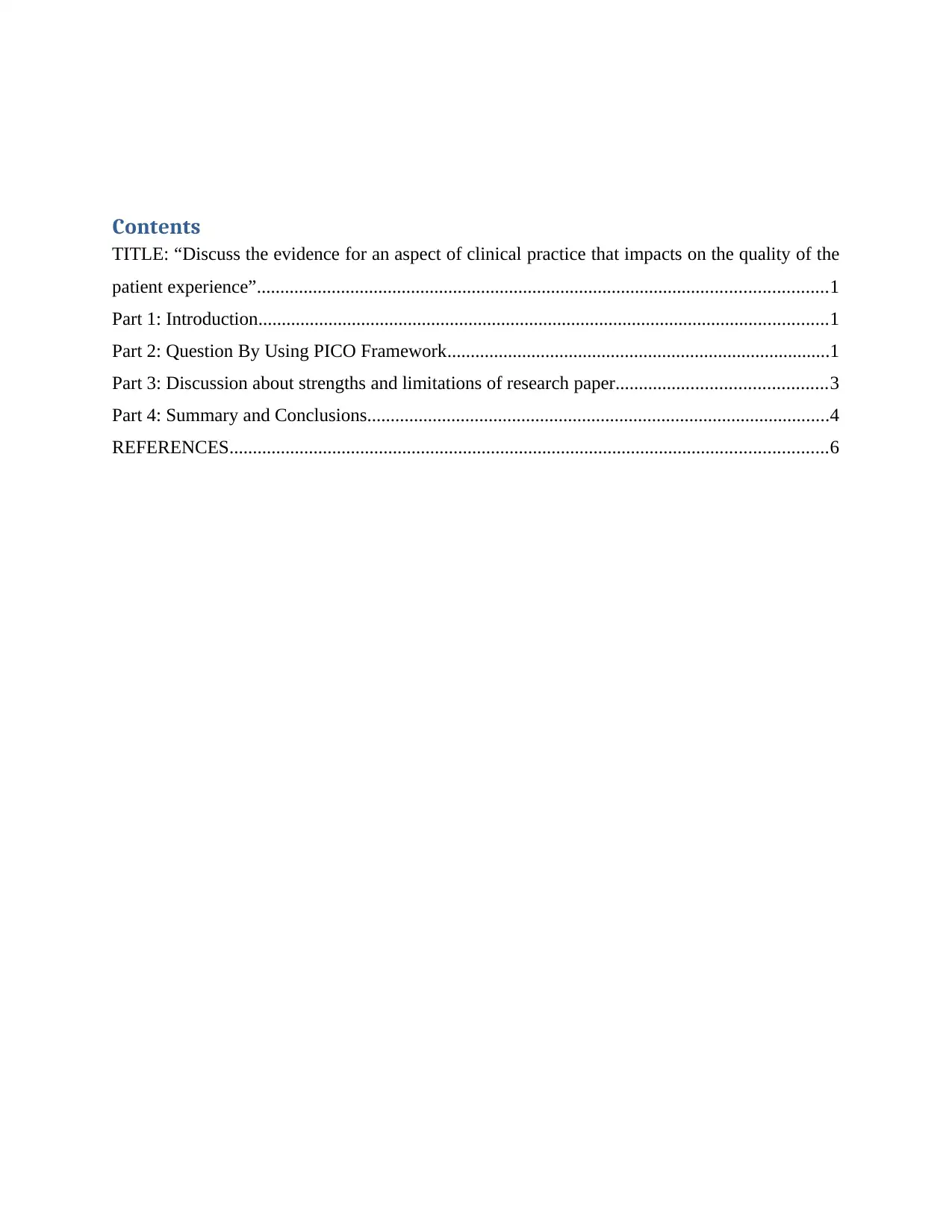
Contents
TITLE: “Discuss the evidence for an aspect of clinical practice that impacts on the quality of the
patient experience”..........................................................................................................................1
Part 1: Introduction..........................................................................................................................1
Part 2: Question By Using PICO Framework..................................................................................1
Part 3: Discussion about strengths and limitations of research paper.............................................3
Part 4: Summary and Conclusions...................................................................................................4
REFERENCES................................................................................................................................6
TITLE: “Discuss the evidence for an aspect of clinical practice that impacts on the quality of the
patient experience”..........................................................................................................................1
Part 1: Introduction..........................................................................................................................1
Part 2: Question By Using PICO Framework..................................................................................1
Part 3: Discussion about strengths and limitations of research paper.............................................3
Part 4: Summary and Conclusions...................................................................................................4
REFERENCES................................................................................................................................6
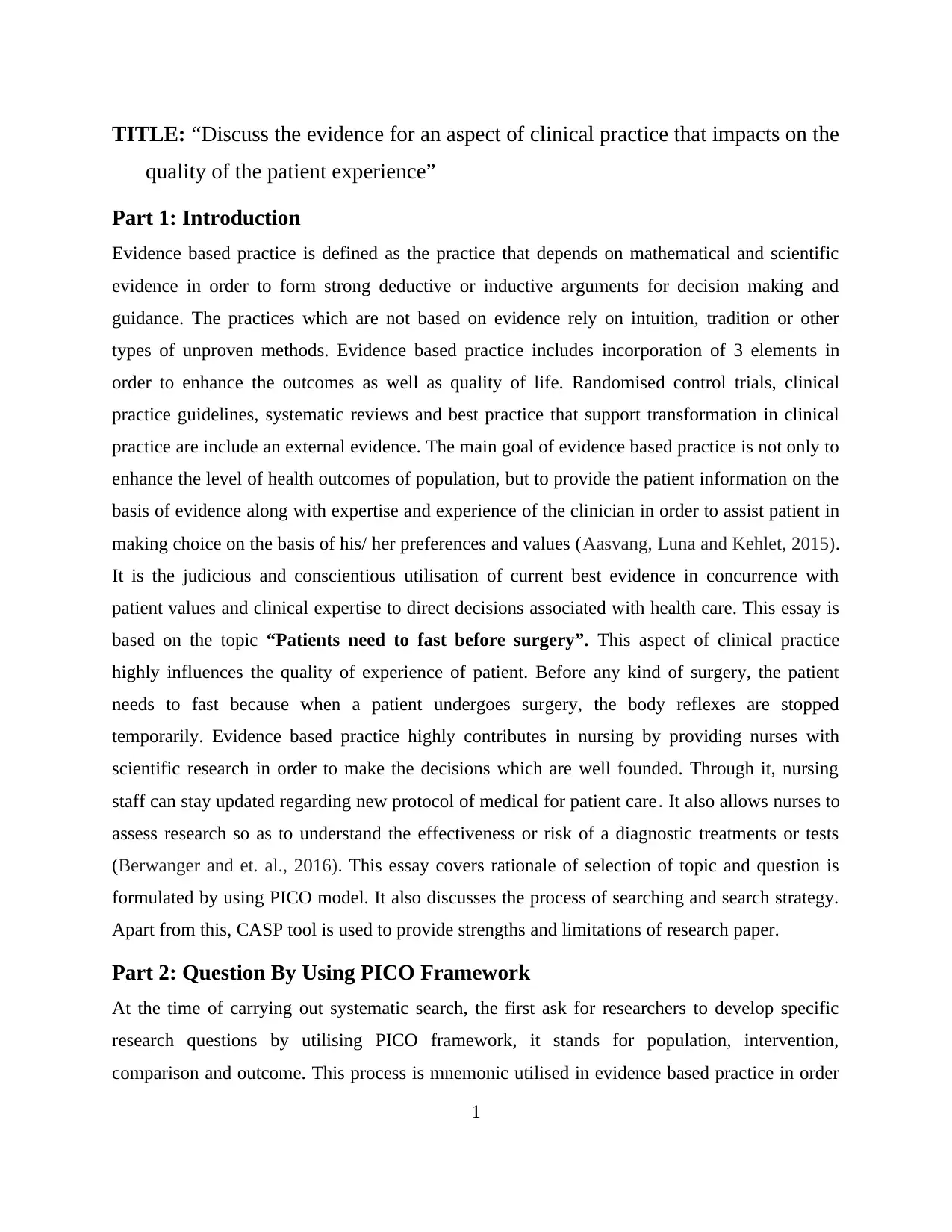
TITLE: “Discuss the evidence for an aspect of clinical practice that impacts on the
quality of the patient experience”
Part 1: Introduction
Evidence based practice is defined as the practice that depends on mathematical and scientific
evidence in order to form strong deductive or inductive arguments for decision making and
guidance. The practices which are not based on evidence rely on intuition, tradition or other
types of unproven methods. Evidence based practice includes incorporation of 3 elements in
order to enhance the outcomes as well as quality of life. Randomised control trials, clinical
practice guidelines, systematic reviews and best practice that support transformation in clinical
practice are include an external evidence. The main goal of evidence based practice is not only to
enhance the level of health outcomes of population, but to provide the patient information on the
basis of evidence along with expertise and experience of the clinician in order to assist patient in
making choice on the basis of his/ her preferences and values (Aasvang, Luna and Kehlet, 2015).
It is the judicious and conscientious utilisation of current best evidence in concurrence with
patient values and clinical expertise to direct decisions associated with health care. This essay is
based on the topic “Patients need to fast before surgery”. This aspect of clinical practice
highly influences the quality of experience of patient. Before any kind of surgery, the patient
needs to fast because when a patient undergoes surgery, the body reflexes are stopped
temporarily. Evidence based practice highly contributes in nursing by providing nurses with
scientific research in order to make the decisions which are well founded. Through it, nursing
staff can stay updated regarding new protocol of medical for patient care. It also allows nurses to
assess research so as to understand the effectiveness or risk of a diagnostic treatments or tests
(Berwanger and et. al., 2016). This essay covers rationale of selection of topic and question is
formulated by using PICO model. It also discusses the process of searching and search strategy.
Apart from this, CASP tool is used to provide strengths and limitations of research paper.
Part 2: Question By Using PICO Framework
At the time of carrying out systematic search, the first ask for researchers to develop specific
research questions by utilising PICO framework, it stands for population, intervention,
comparison and outcome. This process is mnemonic utilised in evidence based practice in order
1
quality of the patient experience”
Part 1: Introduction
Evidence based practice is defined as the practice that depends on mathematical and scientific
evidence in order to form strong deductive or inductive arguments for decision making and
guidance. The practices which are not based on evidence rely on intuition, tradition or other
types of unproven methods. Evidence based practice includes incorporation of 3 elements in
order to enhance the outcomes as well as quality of life. Randomised control trials, clinical
practice guidelines, systematic reviews and best practice that support transformation in clinical
practice are include an external evidence. The main goal of evidence based practice is not only to
enhance the level of health outcomes of population, but to provide the patient information on the
basis of evidence along with expertise and experience of the clinician in order to assist patient in
making choice on the basis of his/ her preferences and values (Aasvang, Luna and Kehlet, 2015).
It is the judicious and conscientious utilisation of current best evidence in concurrence with
patient values and clinical expertise to direct decisions associated with health care. This essay is
based on the topic “Patients need to fast before surgery”. This aspect of clinical practice
highly influences the quality of experience of patient. Before any kind of surgery, the patient
needs to fast because when a patient undergoes surgery, the body reflexes are stopped
temporarily. Evidence based practice highly contributes in nursing by providing nurses with
scientific research in order to make the decisions which are well founded. Through it, nursing
staff can stay updated regarding new protocol of medical for patient care. It also allows nurses to
assess research so as to understand the effectiveness or risk of a diagnostic treatments or tests
(Berwanger and et. al., 2016). This essay covers rationale of selection of topic and question is
formulated by using PICO model. It also discusses the process of searching and search strategy.
Apart from this, CASP tool is used to provide strengths and limitations of research paper.
Part 2: Question By Using PICO Framework
At the time of carrying out systematic search, the first ask for researchers to develop specific
research questions by utilising PICO framework, it stands for population, intervention,
comparison and outcome. This process is mnemonic utilised in evidence based practice in order
1
⊘ This is a preview!⊘
Do you want full access?
Subscribe today to unlock all pages.

Trusted by 1+ million students worldwide
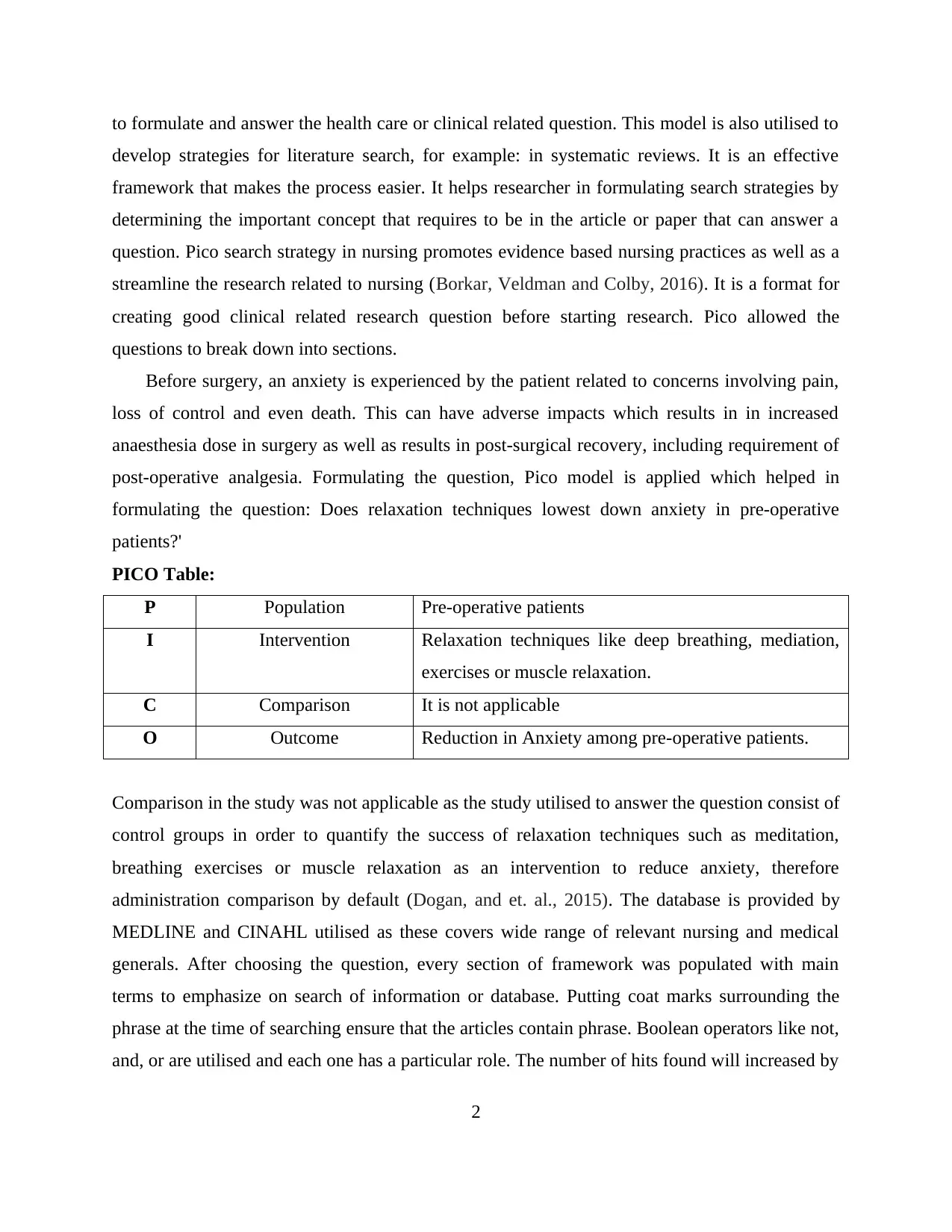
to formulate and answer the health care or clinical related question. This model is also utilised to
develop strategies for literature search, for example: in systematic reviews. It is an effective
framework that makes the process easier. It helps researcher in formulating search strategies by
determining the important concept that requires to be in the article or paper that can answer a
question. Pico search strategy in nursing promotes evidence based nursing practices as well as a
streamline the research related to nursing (Borkar, Veldman and Colby, 2016). It is a format for
creating good clinical related research question before starting research. Pico allowed the
questions to break down into sections.
Before surgery, an anxiety is experienced by the patient related to concerns involving pain,
loss of control and even death. This can have adverse impacts which results in in increased
anaesthesia dose in surgery as well as results in post-surgical recovery, including requirement of
post-operative analgesia. Formulating the question, Pico model is applied which helped in
formulating the question: Does relaxation techniques lowest down anxiety in pre-operative
patients?'
PICO Table:
P Population Pre-operative patients
I Intervention Relaxation techniques like deep breathing, mediation,
exercises or muscle relaxation.
C Comparison It is not applicable
O Outcome Reduction in Anxiety among pre-operative patients.
Comparison in the study was not applicable as the study utilised to answer the question consist of
control groups in order to quantify the success of relaxation techniques such as meditation,
breathing exercises or muscle relaxation as an intervention to reduce anxiety, therefore
administration comparison by default (Dogan, and et. al., 2015). The database is provided by
MEDLINE and CINAHL utilised as these covers wide range of relevant nursing and medical
generals. After choosing the question, every section of framework was populated with main
terms to emphasize on search of information or database. Putting coat marks surrounding the
phrase at the time of searching ensure that the articles contain phrase. Boolean operators like not,
and, or are utilised and each one has a particular role. The number of hits found will increased by
2
develop strategies for literature search, for example: in systematic reviews. It is an effective
framework that makes the process easier. It helps researcher in formulating search strategies by
determining the important concept that requires to be in the article or paper that can answer a
question. Pico search strategy in nursing promotes evidence based nursing practices as well as a
streamline the research related to nursing (Borkar, Veldman and Colby, 2016). It is a format for
creating good clinical related research question before starting research. Pico allowed the
questions to break down into sections.
Before surgery, an anxiety is experienced by the patient related to concerns involving pain,
loss of control and even death. This can have adverse impacts which results in in increased
anaesthesia dose in surgery as well as results in post-surgical recovery, including requirement of
post-operative analgesia. Formulating the question, Pico model is applied which helped in
formulating the question: Does relaxation techniques lowest down anxiety in pre-operative
patients?'
PICO Table:
P Population Pre-operative patients
I Intervention Relaxation techniques like deep breathing, mediation,
exercises or muscle relaxation.
C Comparison It is not applicable
O Outcome Reduction in Anxiety among pre-operative patients.
Comparison in the study was not applicable as the study utilised to answer the question consist of
control groups in order to quantify the success of relaxation techniques such as meditation,
breathing exercises or muscle relaxation as an intervention to reduce anxiety, therefore
administration comparison by default (Dogan, and et. al., 2015). The database is provided by
MEDLINE and CINAHL utilised as these covers wide range of relevant nursing and medical
generals. After choosing the question, every section of framework was populated with main
terms to emphasize on search of information or database. Putting coat marks surrounding the
phrase at the time of searching ensure that the articles contain phrase. Boolean operators like not,
and, or are utilised and each one has a particular role. The number of hits found will increased by
2
Paraphrase This Document
Need a fresh take? Get an instant paraphrase of this document with our AI Paraphraser
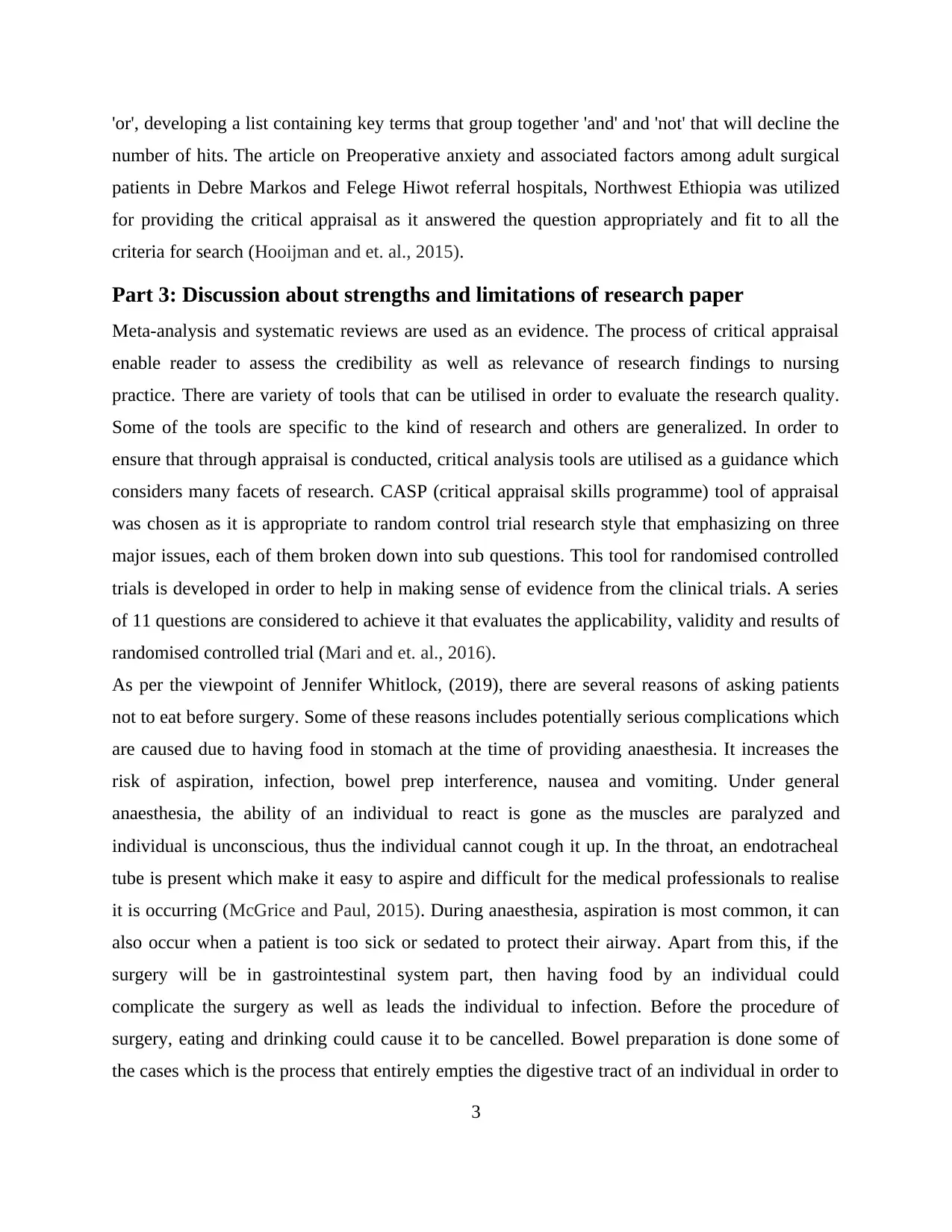
'or', developing a list containing key terms that group together 'and' and 'not' that will decline the
number of hits. The article on Preoperative anxiety and associated factors among adult surgical
patients in Debre Markos and Felege Hiwot referral hospitals, Northwest Ethiopia was utilized
for providing the critical appraisal as it answered the question appropriately and fit to all the
criteria for search (Hooijman and et. al., 2015).
Part 3: Discussion about strengths and limitations of research paper
Meta-analysis and systematic reviews are used as an evidence. The process of critical appraisal
enable reader to assess the credibility as well as relevance of research findings to nursing
practice. There are variety of tools that can be utilised in order to evaluate the research quality.
Some of the tools are specific to the kind of research and others are generalized. In order to
ensure that through appraisal is conducted, critical analysis tools are utilised as a guidance which
considers many facets of research. CASP (critical appraisal skills programme) tool of appraisal
was chosen as it is appropriate to random control trial research style that emphasizing on three
major issues, each of them broken down into sub questions. This tool for randomised controlled
trials is developed in order to help in making sense of evidence from the clinical trials. A series
of 11 questions are considered to achieve it that evaluates the applicability, validity and results of
randomised controlled trial (Mari and et. al., 2016).
As per the viewpoint of Jennifer Whitlock, (2019), there are several reasons of asking patients
not to eat before surgery. Some of these reasons includes potentially serious complications which
are caused due to having food in stomach at the time of providing anaesthesia. It increases the
risk of aspiration, infection, bowel prep interference, nausea and vomiting. Under general
anaesthesia, the ability of an individual to react is gone as the muscles are paralyzed and
individual is unconscious, thus the individual cannot cough it up. In the throat, an endotracheal
tube is present which make it easy to aspire and difficult for the medical professionals to realise
it is occurring (McGrice and Paul, 2015). During anaesthesia, aspiration is most common, it can
also occur when a patient is too sick or sedated to protect their airway. Apart from this, if the
surgery will be in gastrointestinal system part, then having food by an individual could
complicate the surgery as well as leads the individual to infection. Before the procedure of
surgery, eating and drinking could cause it to be cancelled. Bowel preparation is done some of
the cases which is the process that entirely empties the digestive tract of an individual in order to
3
number of hits. The article on Preoperative anxiety and associated factors among adult surgical
patients in Debre Markos and Felege Hiwot referral hospitals, Northwest Ethiopia was utilized
for providing the critical appraisal as it answered the question appropriately and fit to all the
criteria for search (Hooijman and et. al., 2015).
Part 3: Discussion about strengths and limitations of research paper
Meta-analysis and systematic reviews are used as an evidence. The process of critical appraisal
enable reader to assess the credibility as well as relevance of research findings to nursing
practice. There are variety of tools that can be utilised in order to evaluate the research quality.
Some of the tools are specific to the kind of research and others are generalized. In order to
ensure that through appraisal is conducted, critical analysis tools are utilised as a guidance which
considers many facets of research. CASP (critical appraisal skills programme) tool of appraisal
was chosen as it is appropriate to random control trial research style that emphasizing on three
major issues, each of them broken down into sub questions. This tool for randomised controlled
trials is developed in order to help in making sense of evidence from the clinical trials. A series
of 11 questions are considered to achieve it that evaluates the applicability, validity and results of
randomised controlled trial (Mari and et. al., 2016).
As per the viewpoint of Jennifer Whitlock, (2019), there are several reasons of asking patients
not to eat before surgery. Some of these reasons includes potentially serious complications which
are caused due to having food in stomach at the time of providing anaesthesia. It increases the
risk of aspiration, infection, bowel prep interference, nausea and vomiting. Under general
anaesthesia, the ability of an individual to react is gone as the muscles are paralyzed and
individual is unconscious, thus the individual cannot cough it up. In the throat, an endotracheal
tube is present which make it easy to aspire and difficult for the medical professionals to realise
it is occurring (McGrice and Paul, 2015). During anaesthesia, aspiration is most common, it can
also occur when a patient is too sick or sedated to protect their airway. Apart from this, if the
surgery will be in gastrointestinal system part, then having food by an individual could
complicate the surgery as well as leads the individual to infection. Before the procedure of
surgery, eating and drinking could cause it to be cancelled. Bowel preparation is done some of
the cases which is the process that entirely empties the digestive tract of an individual in order to
3
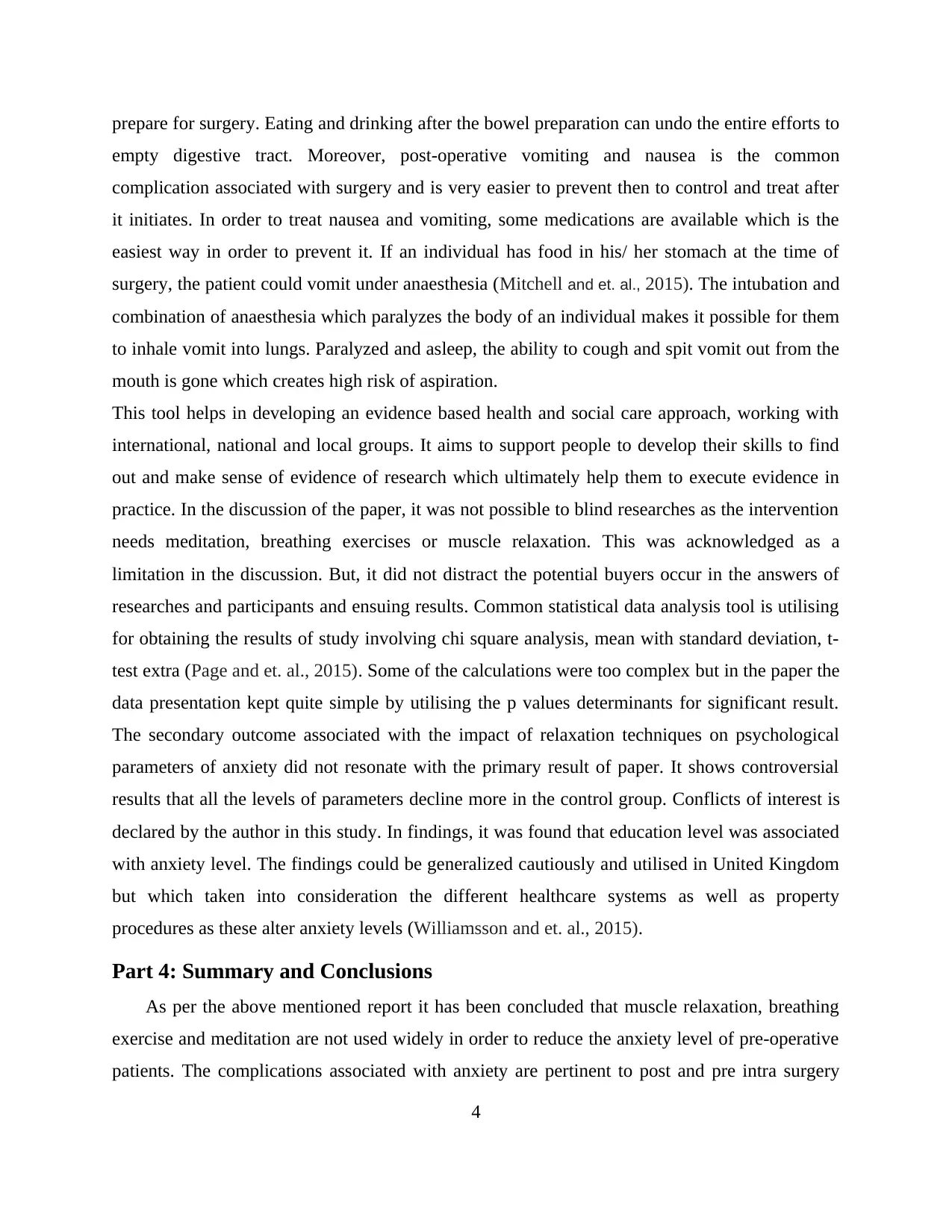
prepare for surgery. Eating and drinking after the bowel preparation can undo the entire efforts to
empty digestive tract. Moreover, post-operative vomiting and nausea is the common
complication associated with surgery and is very easier to prevent then to control and treat after
it initiates. In order to treat nausea and vomiting, some medications are available which is the
easiest way in order to prevent it. If an individual has food in his/ her stomach at the time of
surgery, the patient could vomit under anaesthesia (Mitchell and et. al., 2015). The intubation and
combination of anaesthesia which paralyzes the body of an individual makes it possible for them
to inhale vomit into lungs. Paralyzed and asleep, the ability to cough and spit vomit out from the
mouth is gone which creates high risk of aspiration.
This tool helps in developing an evidence based health and social care approach, working with
international, national and local groups. It aims to support people to develop their skills to find
out and make sense of evidence of research which ultimately help them to execute evidence in
practice. In the discussion of the paper, it was not possible to blind researches as the intervention
needs meditation, breathing exercises or muscle relaxation. This was acknowledged as a
limitation in the discussion. But, it did not distract the potential buyers occur in the answers of
researches and participants and ensuing results. Common statistical data analysis tool is utilising
for obtaining the results of study involving chi square analysis, mean with standard deviation, t-
test extra (Page and et. al., 2015). Some of the calculations were too complex but in the paper the
data presentation kept quite simple by utilising the p values determinants for significant result.
The secondary outcome associated with the impact of relaxation techniques on psychological
parameters of anxiety did not resonate with the primary result of paper. It shows controversial
results that all the levels of parameters decline more in the control group. Conflicts of interest is
declared by the author in this study. In findings, it was found that education level was associated
with anxiety level. The findings could be generalized cautiously and utilised in United Kingdom
but which taken into consideration the different healthcare systems as well as property
procedures as these alter anxiety levels (Williamsson and et. al., 2015).
Part 4: Summary and Conclusions
As per the above mentioned report it has been concluded that muscle relaxation, breathing
exercise and meditation are not used widely in order to reduce the anxiety level of pre-operative
patients. The complications associated with anxiety are pertinent to post and pre intra surgery
4
empty digestive tract. Moreover, post-operative vomiting and nausea is the common
complication associated with surgery and is very easier to prevent then to control and treat after
it initiates. In order to treat nausea and vomiting, some medications are available which is the
easiest way in order to prevent it. If an individual has food in his/ her stomach at the time of
surgery, the patient could vomit under anaesthesia (Mitchell and et. al., 2015). The intubation and
combination of anaesthesia which paralyzes the body of an individual makes it possible for them
to inhale vomit into lungs. Paralyzed and asleep, the ability to cough and spit vomit out from the
mouth is gone which creates high risk of aspiration.
This tool helps in developing an evidence based health and social care approach, working with
international, national and local groups. It aims to support people to develop their skills to find
out and make sense of evidence of research which ultimately help them to execute evidence in
practice. In the discussion of the paper, it was not possible to blind researches as the intervention
needs meditation, breathing exercises or muscle relaxation. This was acknowledged as a
limitation in the discussion. But, it did not distract the potential buyers occur in the answers of
researches and participants and ensuing results. Common statistical data analysis tool is utilising
for obtaining the results of study involving chi square analysis, mean with standard deviation, t-
test extra (Page and et. al., 2015). Some of the calculations were too complex but in the paper the
data presentation kept quite simple by utilising the p values determinants for significant result.
The secondary outcome associated with the impact of relaxation techniques on psychological
parameters of anxiety did not resonate with the primary result of paper. It shows controversial
results that all the levels of parameters decline more in the control group. Conflicts of interest is
declared by the author in this study. In findings, it was found that education level was associated
with anxiety level. The findings could be generalized cautiously and utilised in United Kingdom
but which taken into consideration the different healthcare systems as well as property
procedures as these alter anxiety levels (Williamsson and et. al., 2015).
Part 4: Summary and Conclusions
As per the above mentioned report it has been concluded that muscle relaxation, breathing
exercise and meditation are not used widely in order to reduce the anxiety level of pre-operative
patients. The complications associated with anxiety are pertinent to post and pre intra surgery
4
⊘ This is a preview!⊘
Do you want full access?
Subscribe today to unlock all pages.

Trusted by 1+ million students worldwide
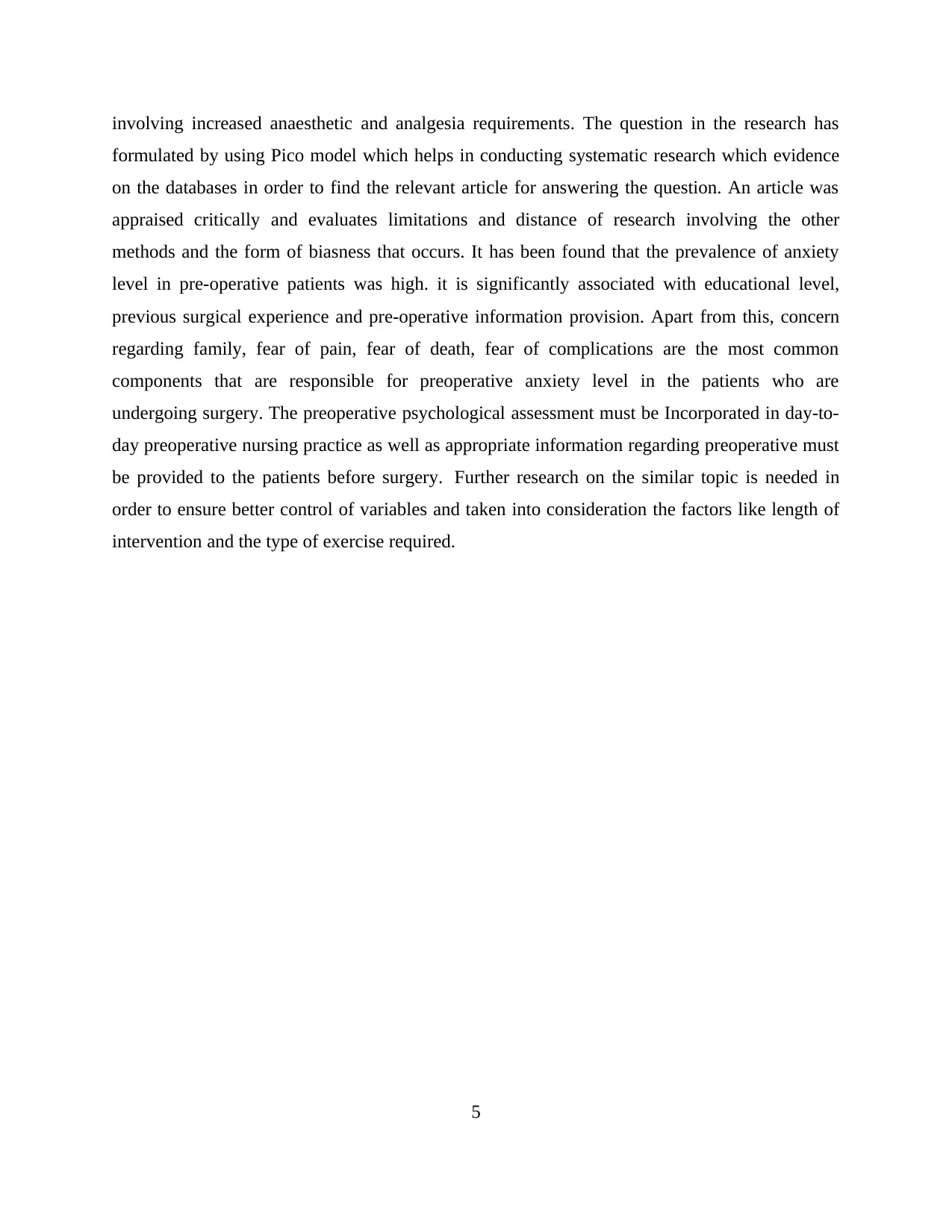
involving increased anaesthetic and analgesia requirements. The question in the research has
formulated by using Pico model which helps in conducting systematic research which evidence
on the databases in order to find the relevant article for answering the question. An article was
appraised critically and evaluates limitations and distance of research involving the other
methods and the form of biasness that occurs. It has been found that the prevalence of anxiety
level in pre-operative patients was high. it is significantly associated with educational level,
previous surgical experience and pre-operative information provision. Apart from this, concern
regarding family, fear of pain, fear of death, fear of complications are the most common
components that are responsible for preoperative anxiety level in the patients who are
undergoing surgery. The preoperative psychological assessment must be Incorporated in day-to-
day preoperative nursing practice as well as appropriate information regarding preoperative must
be provided to the patients before surgery. Further research on the similar topic is needed in
order to ensure better control of variables and taken into consideration the factors like length of
intervention and the type of exercise required.
5
formulated by using Pico model which helps in conducting systematic research which evidence
on the databases in order to find the relevant article for answering the question. An article was
appraised critically and evaluates limitations and distance of research involving the other
methods and the form of biasness that occurs. It has been found that the prevalence of anxiety
level in pre-operative patients was high. it is significantly associated with educational level,
previous surgical experience and pre-operative information provision. Apart from this, concern
regarding family, fear of pain, fear of death, fear of complications are the most common
components that are responsible for preoperative anxiety level in the patients who are
undergoing surgery. The preoperative psychological assessment must be Incorporated in day-to-
day preoperative nursing practice as well as appropriate information regarding preoperative must
be provided to the patients before surgery. Further research on the similar topic is needed in
order to ensure better control of variables and taken into consideration the factors like length of
intervention and the type of exercise required.
5
Paraphrase This Document
Need a fresh take? Get an instant paraphrase of this document with our AI Paraphraser
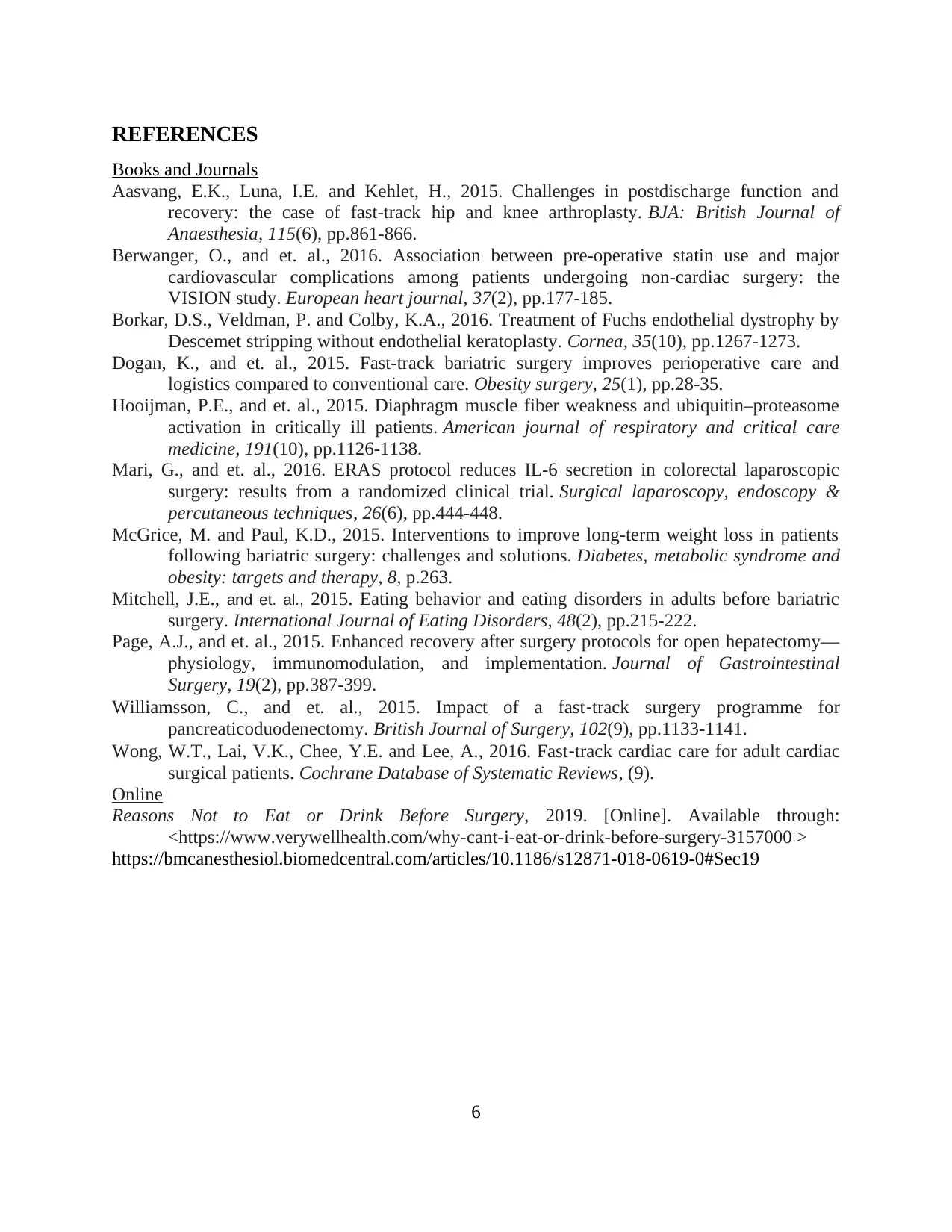
REFERENCES
Books and Journals
Aasvang, E.K., Luna, I.E. and Kehlet, H., 2015. Challenges in postdischarge function and
recovery: the case of fast-track hip and knee arthroplasty. BJA: British Journal of
Anaesthesia, 115(6), pp.861-866.
Berwanger, O., and et. al., 2016. Association between pre-operative statin use and major
cardiovascular complications among patients undergoing non-cardiac surgery: the
VISION study. European heart journal, 37(2), pp.177-185.
Borkar, D.S., Veldman, P. and Colby, K.A., 2016. Treatment of Fuchs endothelial dystrophy by
Descemet stripping without endothelial keratoplasty. Cornea, 35(10), pp.1267-1273.
Dogan, K., and et. al., 2015. Fast-track bariatric surgery improves perioperative care and
logistics compared to conventional care. Obesity surgery, 25(1), pp.28-35.
Hooijman, P.E., and et. al., 2015. Diaphragm muscle fiber weakness and ubiquitin–proteasome
activation in critically ill patients. American journal of respiratory and critical care
medicine, 191(10), pp.1126-1138.
Mari, G., and et. al., 2016. ERAS protocol reduces IL-6 secretion in colorectal laparoscopic
surgery: results from a randomized clinical trial. Surgical laparoscopy, endoscopy &
percutaneous techniques, 26(6), pp.444-448.
McGrice, M. and Paul, K.D., 2015. Interventions to improve long-term weight loss in patients
following bariatric surgery: challenges and solutions. Diabetes, metabolic syndrome and
obesity: targets and therapy, 8, p.263.
Mitchell, J.E., and et. al., 2015. Eating behavior and eating disorders in adults before bariatric
surgery. International Journal of Eating Disorders, 48(2), pp.215-222.
Page, A.J., and et. al., 2015. Enhanced recovery after surgery protocols for open hepatectomy—
physiology, immunomodulation, and implementation. Journal of Gastrointestinal
Surgery, 19(2), pp.387-399.
Williamsson, C., and et. al., 2015. Impact of a fast‐track surgery programme for
pancreaticoduodenectomy. British Journal of Surgery, 102(9), pp.1133-1141.
Wong, W.T., Lai, V.K., Chee, Y.E. and Lee, A., 2016. Fast‐track cardiac care for adult cardiac
surgical patients. Cochrane Database of Systematic Reviews, (9).
Online
Reasons Not to Eat or Drink Before Surgery, 2019. [Online]. Available through:
<https://www.verywellhealth.com/why-cant-i-eat-or-drink-before-surgery-3157000 >
https://bmcanesthesiol.biomedcentral.com/articles/10.1186/s12871-018-0619-0#Sec19
6
Books and Journals
Aasvang, E.K., Luna, I.E. and Kehlet, H., 2015. Challenges in postdischarge function and
recovery: the case of fast-track hip and knee arthroplasty. BJA: British Journal of
Anaesthesia, 115(6), pp.861-866.
Berwanger, O., and et. al., 2016. Association between pre-operative statin use and major
cardiovascular complications among patients undergoing non-cardiac surgery: the
VISION study. European heart journal, 37(2), pp.177-185.
Borkar, D.S., Veldman, P. and Colby, K.A., 2016. Treatment of Fuchs endothelial dystrophy by
Descemet stripping without endothelial keratoplasty. Cornea, 35(10), pp.1267-1273.
Dogan, K., and et. al., 2015. Fast-track bariatric surgery improves perioperative care and
logistics compared to conventional care. Obesity surgery, 25(1), pp.28-35.
Hooijman, P.E., and et. al., 2015. Diaphragm muscle fiber weakness and ubiquitin–proteasome
activation in critically ill patients. American journal of respiratory and critical care
medicine, 191(10), pp.1126-1138.
Mari, G., and et. al., 2016. ERAS protocol reduces IL-6 secretion in colorectal laparoscopic
surgery: results from a randomized clinical trial. Surgical laparoscopy, endoscopy &
percutaneous techniques, 26(6), pp.444-448.
McGrice, M. and Paul, K.D., 2015. Interventions to improve long-term weight loss in patients
following bariatric surgery: challenges and solutions. Diabetes, metabolic syndrome and
obesity: targets and therapy, 8, p.263.
Mitchell, J.E., and et. al., 2015. Eating behavior and eating disorders in adults before bariatric
surgery. International Journal of Eating Disorders, 48(2), pp.215-222.
Page, A.J., and et. al., 2015. Enhanced recovery after surgery protocols for open hepatectomy—
physiology, immunomodulation, and implementation. Journal of Gastrointestinal
Surgery, 19(2), pp.387-399.
Williamsson, C., and et. al., 2015. Impact of a fast‐track surgery programme for
pancreaticoduodenectomy. British Journal of Surgery, 102(9), pp.1133-1141.
Wong, W.T., Lai, V.K., Chee, Y.E. and Lee, A., 2016. Fast‐track cardiac care for adult cardiac
surgical patients. Cochrane Database of Systematic Reviews, (9).
Online
Reasons Not to Eat or Drink Before Surgery, 2019. [Online]. Available through:
<https://www.verywellhealth.com/why-cant-i-eat-or-drink-before-surgery-3157000 >
https://bmcanesthesiol.biomedcentral.com/articles/10.1186/s12871-018-0619-0#Sec19
6
1 out of 8
Related Documents
Your All-in-One AI-Powered Toolkit for Academic Success.
+13062052269
info@desklib.com
Available 24*7 on WhatsApp / Email
![[object Object]](/_next/static/media/star-bottom.7253800d.svg)
Unlock your academic potential
Copyright © 2020–2025 A2Z Services. All Rights Reserved. Developed and managed by ZUCOL.




